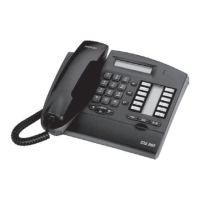35
TRANSMISSION OF DTMF CODES (OR
END-TO-END SIGNALING)
CALL SERVER : TELEPHONE FEATURES
Ed. 04 1/4Réf. 3EH 21000 BSAA
File
TRANSMISSION OF DTMF CODES (OR
END-TO-END SIGNALING)
DESCRIPTION
A station can dial either:
- in decadic mode, or
- in DTMF (dual-tone multi-frequencies)
In order to use the services of a server or a telephone answering device, a station must use DTMF dia-
ling so that the PABX can forward the digits dialed to this server without analyzing them.
A DTMF dialing station does this implicitly since it generates the DTMF dialing itself.
A decadic dialing station must activate the DTMF end-to-end signaling function. The digits dialed
are then converted into DTMF dialing.
"DTMF end-to-end signaling" can be activated either:
- manually, during internal or external conversation
- automatically, via a pre-recorded number in which a "forced DTMF end-to-end signaling" cha-
racter is programmed, possibly followed by digits to be transmitted in DTMF:
• in the personal speed dial numbers (internal or external number)
• in the collective speed dial numbers (external number)
- on a direct call key (internal or external number)
- automatically, during an internal or external conversation, via DTMF end-to-end signaling pro-
gramming for each station or system.
CONFIGURATION
T To modify the value of the time-out during which DTMF end-to-end signaling is active:
- by MMC-PM5 (Expert View):
System Miscellaneous -> Memory Read/Write -> Timer Labels -> "IntDgMfTim"
- by MMC-Station:
Global -> Rd/Wr -> Timers -> "IntDgMfTim" -> Return -> Memory

